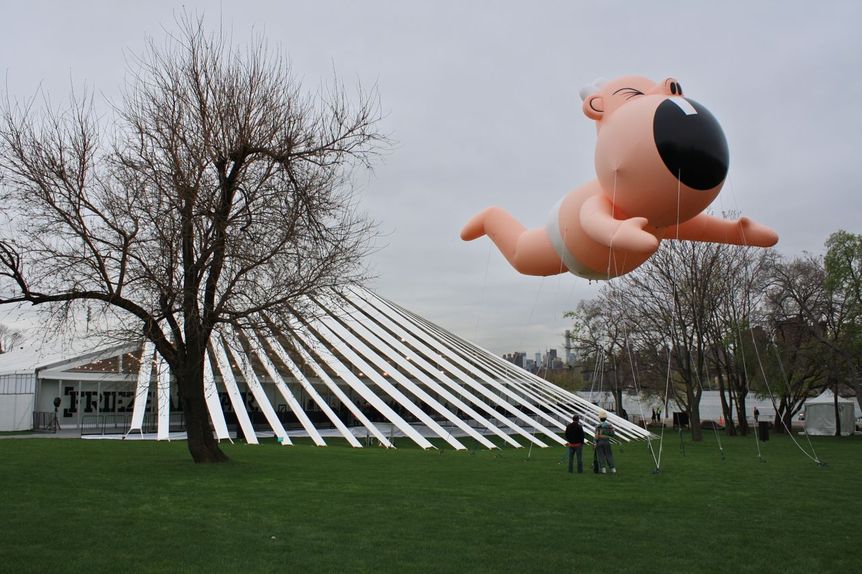The circus-esque tent of Frieze New York, with the Macy’s Thanksgiving Day Parade-like balloon of ALEX DA CORTE floating in the windy, gray sky of New York in early May. All photos by HG Masters for ArtAsiaPacific.
Inside the serpentine circus tent, ShanghArt’s booth featured a trio of XU ZHEN’s monumental figures based on antique sculptures, covered in cut-up landscape paintings. In the background are black-and-white photographs by the duo BIRDHEAD and irregular circle drawings in tape by ZHANG QING.
Salon 94’s booth created this stunning visual pairing between BETTY WOODMAN’s ceramic sculptures Aeolian Pyramid (2001) and Australian indigenous artist WARLIMPIRRNGA TJAPALTJARRI’s paintings.
At Shanghai’s Leo Xu Projects, in the Frame section, LIU SHIYUAN covered the front of the booth with tiles made from slogans and appropriated icons, in an amusing mash-up of visual and verbal truisms, in a work called This Way or That Way (2016).
Lehmann Maupin’s booth featured a selection of works by ex-New Yorker and current Balinese resident ASHLEY BICKERTON. Here, a close-up of his 1992 work Style Piece/Head Trip II, featuring these rusted water-tight containers of film reels.
Taka Ishii’s booth featured older and newer works: with CERITH WYN EVAN’s circular, reflective mobile structure, from 2015, in the foreground and longtime Paris-resident KUMI SUGAI’s 1968 painting Rouge, Vert in the back.
Speaking of circles (of life), at Nature Morte’s booth, was LN TALLUR’s sculpture of charred logs Obituary Note (2013) and IMRAN QURESHI’s paintings merging Mughal miniature painting with the violent remnants of an imagined terrorist attack.
At the conceptual-art specialists MOT International’s booth was NIL YALTER’s photographic project Rahime, Kurdish Woman from Turkey (1979), made with NICOLE CROISET, about a woman moving between her native village and Istanbul.
A close-up of SEUNG TAEK-LEE’s Wind (1972–82), made with rope pieces on canvas, and part of a historical review of the artist’s projects from the late 1950s, at Gallery Hyundai’s main booth.
At Jhaveri Contemporary was a survey of the late ZAHOOR UL-AKHLAQ (1941–1999), with works from the 1990s that bridged Pakistan’s modern and contemporary art movements. Tragically, he and his daughter were murdered in 1999 in their home in Lahore.
At Sfeir-Semler’s booth, two series of WALID RAAD’s works collide: both are about the transportation of artworks and their “escapes” of meaning. On the walls are imagined objects from the Louvre Abu Dhabi’s collection that cast their own shadows. The cut-out shapes on the cardboard boxes represent Iznik ceramic objects that escaped from their containers during their storage by the the World War I-era military government of Turkey.
At CRG gallery, Palestinian artist JUMANA MANNA’s sculptures eerily depict the security apparatus of the Israeli security regime, almost as if they were bodily components.
At Gallery Hyundai’s booth were abstractions by the pioneering artist KIM WHANKI (1913–1974).
Blum & Poe’s booth featured many remnants from its recent exhibitions, including ceramic pieces by KAZUNORI HAMANA and the familiar faces of YOSHITOMO NARA.
Sperone Westwater’s booth featured Tehran-born painter ALI BANISADR’s abstract yet evocative paintings.
At Project 88 was this helpful/unhelpful engraved sign by RAQS MEDIA COLLECTIVE. The instruction not to touch the art becomes convoluted in its repetition.
Finally, at Antenna Space, were these full-sized kites, made to resemble enlarged iPhone screens if they were dusted for figure prints, by LI MING.




